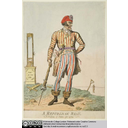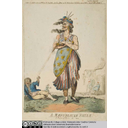15 A Republican Belle and Beau
Isaac Cruickshank
(1756 – 1811)
A Republican Belle. A
Picture of
Etching with
hand-colouring
Published by S.W.
Fores No.3 Piccadilly,
A Republican Beau. A
Picture of
Etching, coloured
Published by S.W.
Fores No.3 Piccadilly,
Published as a pair A Republican Beau and A Republican Belle
satirized the popular French fashion plates of the period, while continuing a
trend in other British caricature to portray the French Revolution as a society
turned upside-down. In
In the caricature of the man, A Republican Beau, the
sans-culotte wears a tattered suit with patriotic French colours of red, white
and blue, topped with a liberty cap. To his left is a guillotine, on which is
proclaimed ‘THIS IS OUR GOD’. He is armed with a bloody dagger, two pistols and
a spiked club. From a side pocket protrudes the body of a child, labelled, “for
stew.” The female equivalent, A Republican Belle, is shown holding a dagger in
one hand and a pistol in the other. She is the complete opposite of a
traditional image of a respectable woman and proper mother. She shows no
concern for her child and allows a pistol to discharge near it. The guillotine
is feminised in this image by its display as jewellery, hanging on a necklace
and earrings. Gruesome humour is everywhere. Attentive viewers will guess that
the pub in the background is called The King’s Head, and here drinkers are
playing skittles with the guillotine’s products. In both caricatures, bodies
hang in the background and both central figures are shown with elongated jaws
and sunken eyes, suggesting that the figures are subhuman. Both figures are
intended to represent the dark depths of human nature that the Revolution
uncovered.
Licensed under the Creative Commons Attribution Non-commercial Share Alike 3.0 License
This resource has been released as an open educational resource (OER) on a Creative Commons 'Attribution Non-commercial Share Alike' license. This means that once downloaded, content can be modified and improved to complement a particular course. This requires, however, that improvements are recycled back into the OER community. All content present at the time of download must be accordingly credited and, in turn, novel content must be appropriately licensed.

